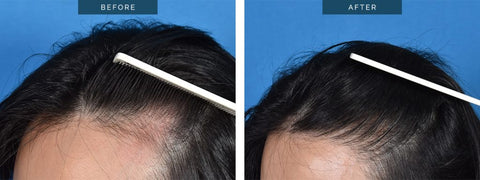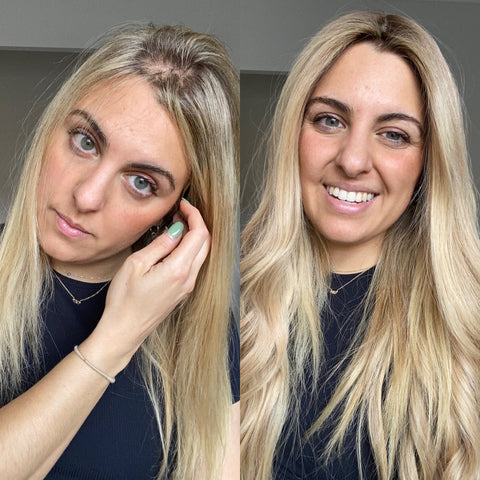If you're like me, you've likely spent countless hours researching and wondering if hair transplants could be the solution to hair loss. You might have come across those impressive before-and-after photos showcasing individuals transforming their thin hair into glorious, luscious locks. In this blog post, we'll delve into the world of hair transplants, assessing whether they are a viable option for different types of hair loss. We'll also explore alternative solutions that can provide comfort and confidence without the need for surgical procedures.

Understanding Hair Transplants
Hair transplants can be an effective solution for some individuals dealing with hair loss. However, it's crucial to consider whether they are suitable for your specific situation. Let's break down the key aspects of hair transplants:
- Who Do Hair Transplants Work For?
The effectiveness of hair transplants varies widely, with success rates ranging from 10% to 80%. Hair transplants are most effective for individuals with smaller areas of hair loss, such as those with receding hairlines or thinning around the hairline. Some forms of male-pattern baldness may also respond well to hair transplants.
On the other hand, individuals with extensive hair loss, such as those with androgenic alopecia affecting the entire crown or scalp, may not be suitable candidates for hair transplants. Additionally, if your hair loss results from an autoimmune condition like alopecia areata, your immune system may continue to target transplanted hair follicles, leading to hair loss in the transplanted area.
Hair transplants are usually not recommended for:
- Chemotherapy patients
- Individuals with thick scalp scars from injuries
- Hair loss caused by medications
- The Cost of Hair Transplants
The cost of a hair transplant can range from $4,000 to $15,000 per session, excluding additional expenses like aftercare medications. Most people require multiple sessions to achieve their desired results.
- Risks and Side Effects
Hair transplants are one of the most invasive procedures for hair loss and come with several potential side effects and risks, including:
- Scarring
- Infections
- Crusting or pus at the transplant site
- Scalp pain
- Itching
- Swelling
- Hair follicle inflammation
- Bleeding
- Loss of sensation
- Visible differences in hair thickness between transplanted and surrounding areas
- Ongoing hair loss if your natural hair continues to thin
The Hair Transplant Procedure
The hair transplant procedure involves several steps:
-
Consultation: Before the procedure, you'll have a consultation with a hair transplant specialist to assess your hair loss, discuss your desired outcome, and determine if you're a suitable candidate.
-
Donor Site Selection: Hair is typically taken from a "donor site," often the back or sides of the head, where hair is more resistant to balding.
-
Preparation for Surgery: On the surgery day, your scalp is cleaned, and a local anesthetic is applied to numb the area. Some clinics may offer sedation for added comfort.
-
Harvesting the Hair: There are two primary methods for harvesting hair—Follicular Unit Transplantation (FUT) and Follicular Unit Extraction (FUE).
-
Preparing the Recipient Site: Tiny incisions are made where hair will be transplanted to mimic natural hair growth patterns.
-
Transplanting the Hair: Grafts from the donor area are placed into the incisions, aligning with natural hair growth direction.
-
Closing and Cleaning: For FUT, the donor area is sutured or stapled closed, while FUE leaves tiny puncture marks that heal naturally. The transplanted area is cleaned and may be covered with a bandage or gauze.
-
Recovery: After the procedure, expect some pain, swelling, or redness. Pain medications and antibiotics may be prescribed, and you'll likely need a few days off work.
-
Hair Growth Post-Transplant: Transplanted hair will initially fall out, but new growth typically begins in a few months. It can take 6-12 months to see significant results.
-
Follow-up: Regular follow-up appointments monitor progress and healing.

The Reality for Alopecia Sufferers
Alopecia presents unique challenges when considering hair transplants due to its autoimmune nature. Even if new hair follicles are transplanted, there's no guarantee that the immune system won't attack them. Extensive hair loss or alopecia universalis can also pose challenges, as there may not be enough donor hair to cover all bald areas.
Exploring Alternative Options
While hair transplants may be tempting for their potential permanence, there are excellent alternatives available. Modern toppers and wigs offer comfort, security, and natural aesthetics without the need for surgery or medications. These options provide immediate results and can boost confidence.
Embracing Other Solutions
Finding the right hair solution can be empowering, and today's options are more advanced than ever. Toppers and wigs offer comfort, security, and natural appearance without the need for surgery or medications. Exploring these alternatives can provide immediate results and enhance your confidence.

Another option is hair fibers. Hair fibers are another simple, instant solution for hair loss. Clingy Fibers is made of 100% organic cotton and natural mineral pigment. They're safe to use on your hair every day and make your hair look instantly thicker.

Conclusion
While hair transplants have helped many individuals regain confidence and achieve their desired look, they are not a one-size-fits-all solution. Consider your unique situation, potential risks, and alternatives before making a decision. Consulting with a dermatologist or hair transplant specialist can provide valuable insights into the best course of action for your postpartum hair loss journey. Remember that the right solution for you is the one that aligns with your goals and makes you feel confident and comfortable.